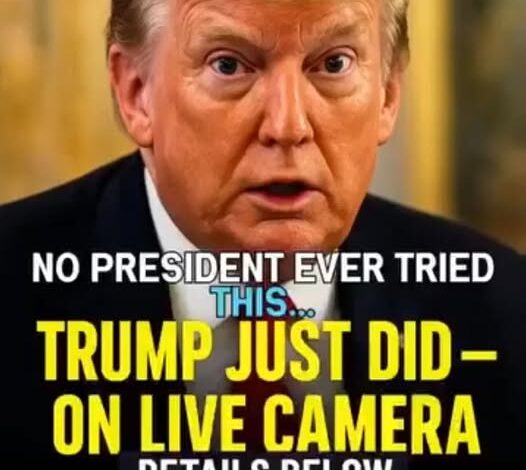
For centuries, presidents have clashed with the press. Some ignored it, some tried to charm it, and others fought with it openly. But in a moment that is now reverberating through the media and political landscape, Donald Trump went further than most by hinting at possible “retaliation” against the press — and he did so live, on camera.
The remarks came during a fiery appearance following widespread coverage of what Trump himself called a “misstep” in an attempted strike on Iran. Clearly angered by how the story was framed, Trump turned his attention not to Iran or to his political opponents but to the American press corps. “The media is out of control,” he said, raising his voice. “Changes are coming.”
The statement was short, but the implications were enormous. What exactly did he mean by “changes”? Was it rhetoric designed to energize supporters, or was it a policy signal suggesting actual legal or regulatory action against journalists and media organizations?
Immediate Fallout: Journalists on Edge
Within hours, Trump’s comments made headlines not only in the United States but also internationally. The Committee to Protect Journalists (CPJ), Reporters Without Borders, and multiple press freedom advocates issued statements condemning the remarks. CPJ warned that Trump’s language “crosses a dangerous line, treating the press not as a constitutional safeguard but as an enemy to be punished.”
“This isn’t just bluster,” one critic said. “When a president openly threatens the press, the line between rhetoric and action begins to blur. Even if nothing concrete happens immediately, the chilling effect is real.”
Journalists, already accustomed to Trump’s frequent attacks on “fake news,” felt the comment had a sharper edge. Many pointed out that presidents in the past have expressed frustration with coverage — Franklin Roosevelt sparred with publishers, Richard Nixon kept enemies’ lists — but rarely has a president floated the idea of “retaliation” so plainly and so publicly.
The First Amendment at the Crossroads
The U.S. Constitution’s First Amendment is clear: “Congress shall make no law … abridging the freedom of speech, or of the press.” But Trump’s remarks, while not tied to specific proposals, invite a deeper question: What happens when the threat to press freedom comes not from Congress or legislation, but from the executive branch through intimidation, public shaming, or implied retaliation?
Legal scholars note that presidents hold significant indirect power over the press. From access to information and White House credentials to the Justice Department’s handling of subpoenas, many levers exist that could quietly restrict journalistic freedom without an outright ban. Even the suggestion of such actions can deter reporters from pursuing hard-hitting stories.
Why It Matters Now
A free press has always been considered one of democracy’s strongest safeguards. Its role is not to please leaders but to hold them accountable. When that role is threatened, even rhetorically, the health of democracy itself comes into question.
Trump’s words arrive at a moment when trust in institutions is already fragile. Surveys show declining public confidence in the media, with partisan divides sharper than ever. For Trump’s supporters, his attacks on the press often feel like truth-telling against biased elites. For his critics, they represent authoritarian drift. Both interpretations fuel polarization.
History’s Lessons
The tension between presidents and the press is nothing new. John Adams signed the Alien and Sedition Acts in 1798, criminalizing criticism of the government — a move later condemned as unconstitutional overreach. Abraham Lincoln, during the Civil War, allowed military censorship of some newspapers. Nixon tried to block publication of the Pentagon Papers.
But what sets Trump’s rhetoric apart is its style: blunt, public, and repeated. Where earlier presidents cloaked their efforts in legal arguments or security justifications, Trump frames his battle with the press as personal — a fight between himself and what he calls “the corrupt media.”
A Warning and a Test
For reporters, the question is no longer just how to cover the news, but how to defend the conditions that make coverage possible. If the press hesitates, democracy weakens. If it resists, it risks further hostility from the nation’s most powerful office.
As one editor put it, “The press doesn’t exist to be liked. It exists to inform, even when the truth is inconvenient to those in power.”
The challenge now is whether journalists, institutions, and the public will recognize the gravity of Trump’s remarks and push back against the normalization of threats to free expression.
A Deeper Reflection
History and philosophy remind us that silence in the face of intimidation is itself a form of submission. A proverb often attributed to Sufi wisdom says: “Silence before oppression is itself a form of speech.” In this light, Trump’s warning is not just a political jab; it is a test of resilience.
Will the press step forward, louder and clearer, in the face of implied retaliation? Or will fear of consequences chip away at its resolve?
The Bottom Line
No president in modern history has spoken so openly about punishing the media. Whether Trump follows through with concrete measures or leaves it as rhetorical fire, the damage is already partly done. The press must not only continue to report but also defend its very right to exist unshackled.
For Americans, the takeaway is sobering: freedom of the press is not guaranteed simply because it is written in the Constitution. It must be protected, day by day, against every effort — overt or subtle — to silence it.
Because if the press is silenced, the people are silenced. And when that happens, democracy itself is no longer out of bounds — it is out of reach.